Watercolour painting tutorial
Watercolor tutorial - Lowick Common
|
In this watercolour painting tutorial I will give you some hints and tips based on a watercolour commission. The task was to paint Lowick Common, a village green in Northumberland, based upon a series of photographs that were supplied by the client. The digital images were mosaiced together to create the best artistic look, while not dtracting from the actual scene. The first challenge was to decide on the compositon of the painting, particularly as the most attractive house around the green was obscured by trees. The first thing to do was to sketch the scene using the classic rule of thirds, placing the red roof building a third in from the right. Before applying any paint apply 'Art Masking Fluid' along the lines of the roofs and chimneys. This rubbery solution can easily be rubbed off after paint has dried. Starting with the sky, I used a pallette of three colours - French Ultramarine, Burnt Umber and Light Red. Remember that the scene is in Northumberland and therefore there are not many days of bright blue sky! A wet-in-wet technique was used for the majority of the sky. With the scene initially upside down I applied a wash of Ultramarine and Light Red for the lower sky in addition to a weak wash of Ultramarine in places. I allowed the paint to cover the tree tops too. Turning the painting right way up, clean water was applied to the paper and Ultramarine added to the top right, wet in wet. The clouds were added using a mix of Ultramarine and Burnt Umber. Still wet in wet, touches of the Ultramarine and Light Red were added here and there. When the sky was completely dry, work on the trees could start. I always mix greens instead of using greens straight from a tube. I mixed three different washes of differing tone using French Ultramarine, Cadmium Yellow and Indigo. Always remember that the distant trees should have a lighter tone than those in the foreground. Also, in order to create the impression of distance, cooler colours should be used for the far away trees and warmer colours are for the foreground. See my pages on colour perspective and how to paint trees for more information. Once the trees were dry, the masking fluid was removed by gently rubbing it with a clean finger. While the greens were still wet in the pallette, the hedge, bush and the stone wall on the right of the painting ware added. For the wall I used a weak wash of raw sienna, adding a touch of green, wet-in-wet, to give the impression of ageing. The red roof of the building was painted with a wash of Burnt Sienna and a touch of Light Red, ensuring that there was a nice contrast between the roof and the foreground trees. Once dry thin horizontal lines were added to give the impression of a tiled roof. The same wash was used for the chimneys. Note that the white chimney stack to the left was previously protected with masking fluid. To the shaded side of the chimney stack and underneath the gutttering a weak wash of Ultramarine and Light Red was applied to give the impression of shadow on the white building. A touch of indigo was added to the same wash for the roof of the adjacent building. The windows were added on each building using a weak wash of Ultramarine wet on dry, and here and there weak indigo was added wet in wet. There is a tendency for beginners to paint the whole shape of the window but this is not necessary. Although the doors on the actual building were black, a strong wash of Indigo was used for the painting - in my view black should never be used! Shadowed areas on the white buildings were given a weak wash of Ultramrine and Light Red. With watercolour painting, suggestions of shapes and shadows are all that is required and the eyes and mind of the viewer does the rest. Thus a hint of window ledges were added. You will notice that I have added some flowers in front of the red roof building in order to break a straight line between the grass and the house. On the left hand buildings various colours were applied to give the impression of flowering gardens. Fresh washes of Ultramarine and Cadmium Yellow were made mixed for the grassed ares of the common. Rather than using a wet in wet technique, for grass I prefer to used wet on dry using the side of the brush, not the tip. On 'grain fin' watercolour paper' this technique ensues that not all the paper is covered by paint. You will note that a darker tone of green has been added to the foreground to give the impression of dapppled shadows from the trees above and behind the viewer. The horizontal part of the park benches was painted with a medium wash of Raw Seinna. A hint of Ultramarine was added to give the impression reflection from the sky. When dry the dark parts of the becnh was painted with Burnt Umber, wet on dry. Finally, the overhanging branches were added with strong washes of Indigo and Cadmium Yellow being used for the leaves and some branches, with others being painted with the Burnt Umber that was used for the benches. Then the leaves and branches were dry an over-wash of Ultramarine and Cadmium Yellow was added so that the branches were not too dark. |
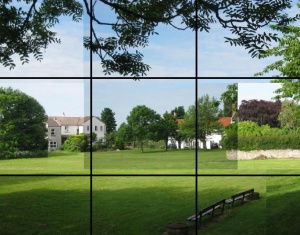
|
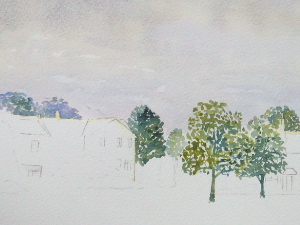
| |
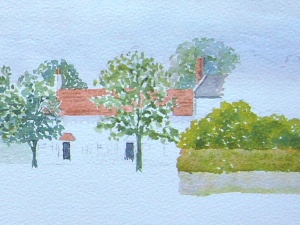
| |
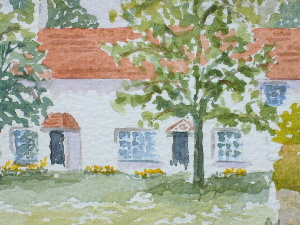
| |
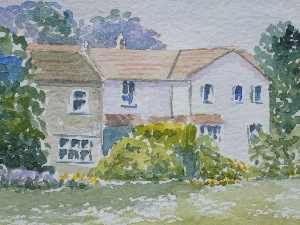
| |
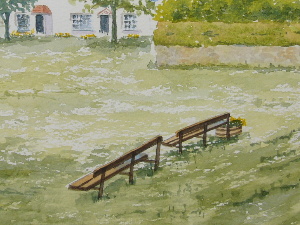
| |
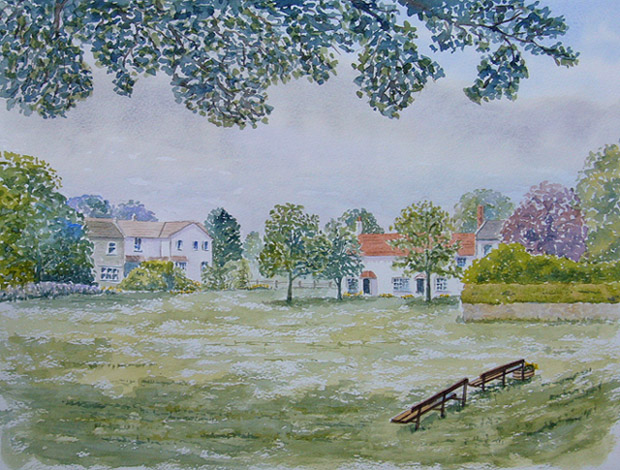
| |
|
Lowick Common | |
Watercolour Paintings Landscapes Minimal Landscapes Wildlife Nudes Beaches and Boats Abstract Commissions Watercolour Gallery
Latest Work
Cockington Collection Lanercost CollectionWatercolor Tutorials
Equipment Colour and Tone Watercolour Washes Wash Techniques Perspective How to Paint Trees Watercolor Tutorial 1 Watercolor Tutorial 2 Watercolor Tutorial 3 Watercolor Tutorial 4Guest Artists
James Baldwin Lucy Toft Hamish CormackCOPYRIGHT All images shown on this website are protected by copyright. No artwork may be reproduced without prior consent by the artists.
Art Links
If you have an art related website and would like to exchange links, please click here.
Art and Design
Web design by zero78

